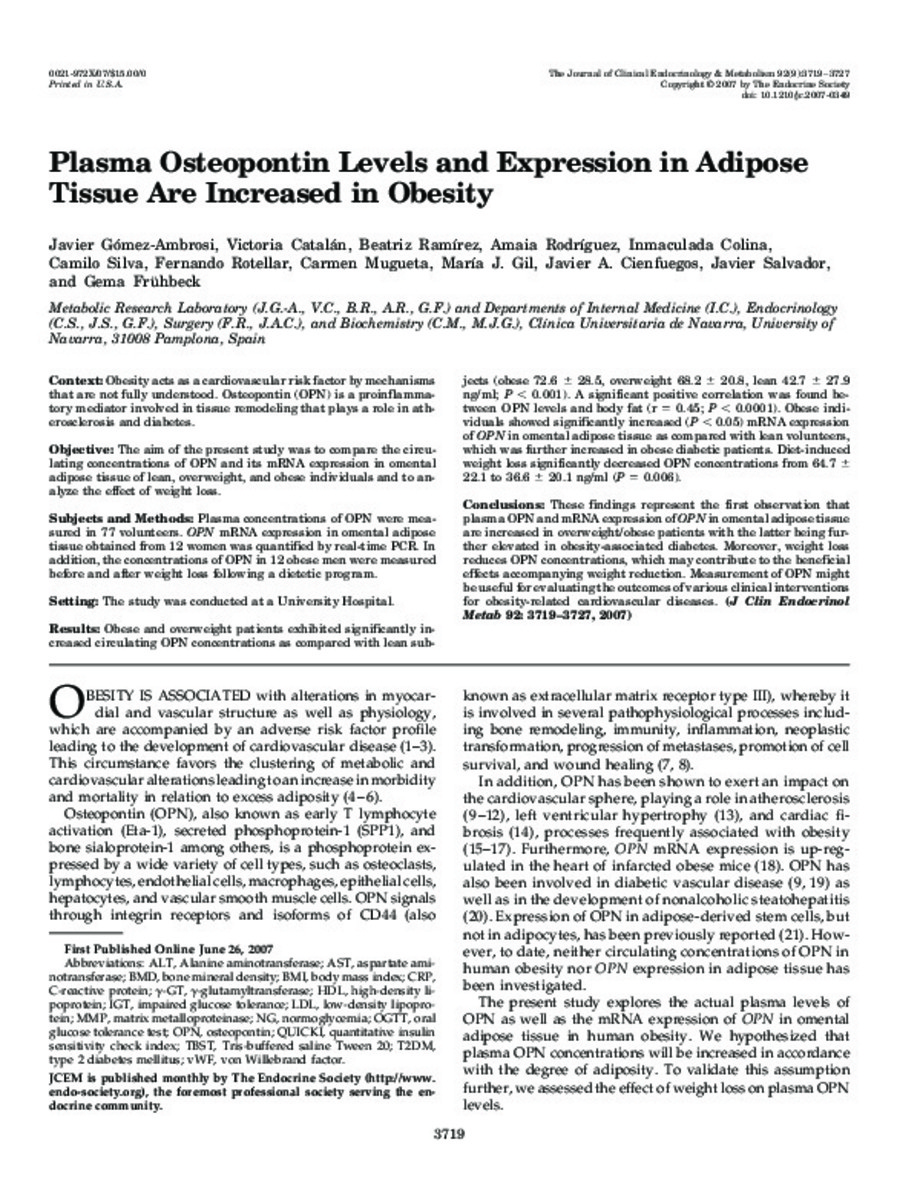Full metadata record
| DC Field | Value | Language |
|---|---|---|
| dc.creator | Gomez-Ambrosi, J. (Javier) | - |
| dc.creator | Catalan, V. (Victoria) | - |
| dc.creator | Ramirez, B. (Beatriz) | - |
| dc.creator | Rodriguez, A. (Amaia) | - |
| dc.creator | Colina, I. (Inmaculada) | - |
| dc.creator | Silva, C. (Camilo) | - |
| dc.creator | Rotellar, F. (Fernando) | - |
| dc.creator | Mugueta, C. (Carmen) | - |
| dc.creator | Gil, M.J. (María José) | - |
| dc.creator | Álvarez-Cienfuegos, J. (Javier) | - |
| dc.creator | Salvador, J. (Javier) | - |
| dc.creator | Frühbeck, G. (Gema) | - |
| dc.date.accessioned | 2012-04-23T14:23:50Z | - |
| dc.date.available | 2012-04-23T14:23:50Z | - |
| dc.date.issued | 2007 | - |
| dc.identifier.citation | Gomez-Ambrosi J, Catalan V, Ramirez B, Rodriguez A, Colina I, Silva C, et al. Plasma osteopontin levels and expression in adipose tissue are increased in obesity. J Clin Endocrinol Metab 2007 Sep;92(9):3719-3727. | es_ES |
| dc.identifier.issn | 0021-972X | - |
| dc.identifier.uri | https://hdl.handle.net/10171/21743 | - |
| dc.description.abstract | Obesity acts as a cardiovascular risk factor by mechanisms that are not fully understood. Osteopontin (OPN) is a proinflammatory mediator involved in tissue remodeling that plays a role in atherosclerosis and diabetes. OBJECTIVE: The aim of the present study was to compare the circulating concentrations of OPN and its mRNA expression in omental adipose tissue of lean, overweight, and obese individuals and to analyze the effect of weight loss. SUBJECTS AND METHODS: Plasma concentrations of OPN were measured in 77 volunteers. OPN mRNA expression in omental adipose tissue obtained from 12 women was quantified by real-time PCR. In addition, the concentrations of OPN in 12 obese men were measured before and after weight loss following a dietetic program. SETTING: The study was conducted at a University Hospital. RESULTS: Obese and overweight patients exhibited significantly increased circulating OPN concentrations as compared with lean subjects (obese 72.6 +/- 28.5, overweight 68.2 +/- 20.8, lean 42.7 +/- 27.9 ng/ml; P < 0.001). A significant positive correlation was found between OPN levels and body fat (r = 0.45; P < 0.0001). Obese individuals showed significantly increased (P < 0.05) mRNA expression of OPN in omental adipose tissue as compared with lean volunteers, which was further increased in obese diabetic patients. Diet-induced weight loss significantly decreased OPN concentrations from 64.7 +/- 22.1 to 36.6 +/- 20.1 ng/ml (P = 0.006). CONCLUSIONS: These findings represent the first observation that plasma OPN and mRNA expression of OPN in omental adipose tissue are increased in overweight/obese patients with the latter being further elevated in obesity-associated diabetes. Moreover, weight loss reduces OPN concentrations, which may contribute to the beneficial effects accompanying weight reduction. Measurement of OPN might be useful for evaluating the outcomes of various clinical interventions for obesity-related cardiovascular diseases | es_ES |
| dc.language.iso | eng | es_ES |
| dc.publisher | Endocrine Society | es_ES |
| dc.rights | info:eu-repo/semantics/openAccess | es_ES |
| dc.subject | Intra-Abdominal Fat/metabolism | es_ES |
| dc.subject | Obesity/blood/diet therapy/genetics | es_ES |
| dc.subject | Osteopontin/blood/genetics | es_ES |
| dc.title | Plasma osteopontin levels and expression in adipose tissue are increased in obesity | es_ES |
| dc.type | info:eu-repo/semantics/article | es_ES |
| dc.type.driver | info:eu-repo/semantics/article | es_ES |
| dc.identifier.doi | http://dx.doi.org/10.1210/jc.2007-0349 | es_ES |
Files in This Item:
Statistics and impact
Items in Dadun are protected by copyright, with all rights reserved, unless otherwise indicated.






